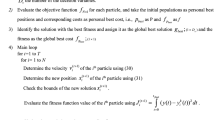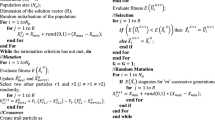Abstract
In this paper a new frequency-domain model order reduction method is proposed for the reduction of higher-order linear continuous-time single input single output systems using a recent hybrid evolutionary algorithm. The hybrid evolutionary algorithm is developed from the mutual synergism of particle swarm optimization and differential evolution algorithm. The objective of the proposed method is to determine an optimal reduced-order model for the given original higher-order linear continuous-time system by minimizing the integral square error (ISE) between their step responses. The method has significant features like easy implementation, good performance, numerically stable and fast convergence. Applicability and efficacy of the method are shown by illustrating an IEEE type-1 DC excitation system, and by a typical ninth-order system taken from the literature. The results obtained from the proposed algorithm are compared with many familiar and recent reduction techniques that are available in the literature, in terms of step ISE values and impulse response energies of the models. Furthermore step and frequency responses are also plotted.








Similar content being viewed by others
References
Aguirre, L. A. (1992). The least-squares Padé method for model reduction. International Journal of Systems Science, 23(10), 1559–1570.
Antoulas, A. C., & Sorensen, D. C. (2001). Approximation of large-scale dynamical systems: An overview. International Journal of Applied Mathematics and Computer Science, 11(5), 1093–1121.
Bansal, J. C., Harish, S., & Arya, K. V. (2011) Model order reduction of single input single output systems using Artificial Bee Colony Optimization algorithm. NICSO-2011, SCI-387 (pp. 85–100).
Boby, P., & Pal, J. (2010). An evolutionary computation based approach for reduced order modelling of linear systems. IEEE International conference on computational intelligence and computing research, Coimbatore, India. doi:10.1109/ICCIC.2010.5705729.
Chen, T., Chang, C., & Han, K. (1979). Reduction of transfer functions by the stability-equation method. Journal of the Franklin Institute, 308(4), 389–404.
Choi, B. K., Chiang, H. D., Wu, H., Li, H., David, C. Y. (2008). Exciter model reduction and validation for large-scale power system dynamic security assessment. IEEE Conference: PES, Pittsburgh (pp. 1–7).
Choo, Y. (1999). Improvement to modified routh approximation method. IEE Electronics Letters, 35(7), 606–607.
Das, S., Ajith, A., & Amit, K. (2008). Particle swarm optimization and differential evolution algorithms: Technical analysis, applications and hybridization perspectives. Studies in Computational Intelligence (SCI), 116, 1–38.
Deepa, S. N., & Sugumaran, G. (2011). MPSO based model order formulation technique for SISO continuous systems. World Academy of Science, Engineering and Technology: International Journal of Mathematical, Computational, Physical, Electrical and Computer Engineering, 5(3), 288–293.
Desai, S. R., & Prasad, R. (2013). A new approach to order reduction using stability equation and big bang big crunch optimization. Systems Science & Control Engineering, 1(1), 20–27.
Farsangi, M. M., NasiriSoloklo, H., & Hajmohammadi, R. (2015). Model order reduction based on moment matching using Legendre wavelet and harmony search algorithm. IJST, Transactions of Electrical Engineering, 39(E1), 39–54.
Fogel, L. J., Owens, A. J., & Walsh, M. J. (1966). Artificial intelligence through simulated evolution. NewYork: Wiley.
George, D. H., & Luss, R. (1990). Model reduction by minimization of integral square error performance indices. Journal of the Franklin Institute, 327(3), 343–357.
Hwang, C. (1984). Mixed method of routh and ise criterion approaches for reduced-order modeling of continuous-time systems. Journal of Dynamic Systems, Measurement, and Control, 106(4), 353–356.
Hwang, C., & Wang, K. Y. (1984). Optimal routh approximations for continuous-time systems. International Journal of Systems Science, 15(3), 249–259.
Jamshidi, M. (1997). Large scale systems: Modeling, control, and fuzzy logic. Upper Saddle River, NJ: Prentice-Hall. Inc.
Kennedy, J., & Eberhart, R. (1995). Particle swarm optimization. IEEE International Conference: Neural Networks, Perth(WA), 4, 1942–1948.
Kennedy, J., Eberhart, R., & Shi, Y. (2001). Swarm intelligence. Burlington: Morgan Kaufmann Academic Press.
Krishnamurthy, V., & Seshadri, V. (1978). Model reduction using the routh stability criterion. IEEE Transactions on Automatic Control, 23(4), 729–731.
Kuo, B. C., & Farid, G. (2007). Automatic control systems (8th ed.). NewYork: Wiley.
Lepschy, A., Antoniomian, G., & Viaro, U. (1988). System approximation by matching the impulse response energies. Journal of the Franklin Institute, 325(1), 17–26.
Lucas, T. N. (1983). Factor division: A useful algorithm in model reduction. IEE Proceedings D: Control Theory and Applications, 130(6), 362–364.
Lucas, T. N. (1993). Optimal model reduction by multipoint pade approximation. Journal of the Franklin Institute, 330(1), 79–91.
Mukherjee, S., & Mishra, R. (1987). Order reduction of linear systems using an error minimization technique. Journal of the Franklin Institute, 323(1), 23–32.
Mukherjee, S., & Mittal, R. C. (2005). Model order reduction using response-matching technique. Journal of the Franklin Institute, 342(5), 503–519.
Munro, A. R., & Lucas, T. N. (1991). Model reduction by generalised least squares method. Electronics Letters, 27(15), 1383–1384.
NasiriSoloklo, H., & Maghfoori Farsangi, M. (2014). Order reduction by minimizing integral square error and \(H_\infty \) norm of error. Journal of Advances in Computer Research, 5(1), 29–42.
Pamar, G., Mukherjee, S., & Prasad, R. (2007). Relative mapping errors of linear time invariant systems caused by particle swarm optimized reduced order model. International Journal of Computer, Information, System Science and Engineering, 1(4), 83–89.
Santosh, K. V. S., Sandeep, G., & Vasu, G. (2012). Reduction of large scale linear dynamic SISO and MIMO systems using differential evolution optimization algorithm. IEEE students conference on electrical, electronics and computer science (pp. 180–185). Bhopal. doi:10.1109/SCEECS.2012.6184732.
Schilders, W. H., VanderVorst, H. A. & Rommes, J. (Eds.) (2008). Model order reduction: Theory, research aspects and applications, Hardcover (pp. 3–32). http://www.springer.com/ISBN:978-3-540-78840-9.
Sikander, A., & Prasad, R. (2015). Soft computing approach for model order reduction of linear time invariant systems. Circuits, Systems, and Signal Processing, 34(11), 3471–3487.
Vasu, G., Sivakumar, M., & Ramalingaraju, M. (2016a). A novel method for optimal model simplification of large scale linear discrete-time systems. International Journal of Automation and Control, 10(2), 120–141.
Vasu, G., Sivakumar, M., & Ramalingaraju, M. (2016b). Optimal least squares model approximation for large-scale linear discrete-time systems. Transactions of the Institute of Measurement and Control,. doi:10.1177/0142331216649023.
Vishwakarma, C. B., & Prasad, R. (2009). MIMO system reduction using modified pole clustering and genetic algorithm. Modelling and Simulation in Engineering, 2009, 1–5. doi:10.1155/2009/540895.
Vishwakarma, C. B., & Prasad, R. (2014). Time domain model order reduction using Hankel matrix approach. Journal of the Franklin Institute, 351(2014), 3445–3456.
Yao, X. (1999). Evolutionary computation: Theory and applications. Singapore: World Scientific Press.
Author information
Authors and Affiliations
Corresponding author
Rights and permissions
About this article
Cite this article
Ganji, V., Mangipudi, S. & Manyala, R. A Novel Model Order Reduction Technique for Linear Continuous-Time Systems Using PSO-DV Algorithm. J Control Autom Electr Syst 28, 68–77 (2017). https://doi.org/10.1007/s40313-016-0284-9
Received:
Revised:
Accepted:
Published:
Issue Date:
DOI: https://doi.org/10.1007/s40313-016-0284-9




